Cliff: Difference between revisions
ClueBot NG (talk | contribs) m Reverting possible vandalism by 161.77.42.70 to version by J 1982. Report False Positive? Thanks, ClueBot NG. (2362728) (Bot) |
Cyberbot II (talk | contribs) Rescuing 1 sources, flagging 0 as dead, and archiving 5 sources. (Peachy 2.0 (alpha 8)) |
||
| Line 128: | Line 128: | ||
* [[Mount Thor]], [[Baffin Island]], [[Canada]]; 1,370 m (4,500 ft) total; top 480 m (1600 ft) is overhanging. This is commonly regarded as being the largest vertical drop on Earth {{citation needed|date=May 2011}} at 1,250 m (4,100 ft). |
* [[Mount Thor]], [[Baffin Island]], [[Canada]]; 1,370 m (4,500 ft) total; top 480 m (1600 ft) is overhanging. This is commonly regarded as being the largest vertical drop on Earth {{citation needed|date=May 2011}} at 1,250 m (4,100 ft). |
||
* The sheer north face of [[Polar sun spire|Polar Sun Spire]], in the [[Sam Ford fjord]] of [[Baffin Island]], rises 4,300 ft above the flat frozen fjord, although the lower portion of the face breaks from the vertical wall with a series of ledges and buttresses.<ref>{{cite web|title=Polar Sun Spire|url=http://www.summitpost.org/mountain/rock/152417/polar-sun-spire.html|accessdate=2008-07-31|publisher=SummitPost.Org}}</ref> |
* The sheer north face of [[Polar sun spire|Polar Sun Spire]], in the [[Sam Ford fjord]] of [[Baffin Island]], rises 4,300 ft above the flat frozen fjord, although the lower portion of the face breaks from the vertical wall with a series of ledges and buttresses.<ref>{{cite web|title=Polar Sun Spire|url=http://www.summitpost.org/mountain/rock/152417/polar-sun-spire.html|accessdate=2008-07-31|publisher=SummitPost.Org}}</ref> |
||
* Ketil's west face in Tasermiut, [[Greenland]] (also known as God's [[Thumbnail (cliff)|Thumbnail]]), has been reported as 1,400 m – 1,450 m high, (although some doubt has been cast on this).<ref>{{cite web|title=Climbing in Tasermiut|url=http://www.bigwall.dk/galleri/klatring/tasermiu/pages-uk/uk05keti.htm|accessdate=2008-09-02|publisher=bigwall.dk}}</ref><ref>{{cite web|title=The American Alpine Journal |year=1986|url=http://www.americanalpineclub.org/AAJO/pdfs/1986/175_canada_greenland_aaj1986.pdf|accessdate=2008-09-02 |
* Ketil's west face in Tasermiut, [[Greenland]] (also known as God's [[Thumbnail (cliff)|Thumbnail]]), has been reported as 1,400 m – 1,450 m high, (although some doubt has been cast on this).<ref>{{cite web|title=Climbing in Tasermiut|url=http://www.bigwall.dk/galleri/klatring/tasermiu/pages-uk/uk05keti.htm|accessdate=2008-09-02|publisher=bigwall.dk}}</ref><ref>{{cite web|title=The American Alpine Journal |year=1986 |url=http://www.americanalpineclub.org/AAJO/pdfs/1986/175_canada_greenland_aaj1986.pdf |accessdate=2008-09-02 |deadurl=yes |archiveurl=https://web.archive.org/20081028235449/http://www.americanalpineclub.org/AAJO/pdfs/1986/175_canada_greenland_aaj1986.pdf |archivedate=October 28, 2008 }}</ref> |
||
Other notable cliffs include: |
Other notable cliffs include: |
||
Revision as of 02:13, 17 October 2015


In geography and geology, a cliff is a vertical, or near vertical, rock exposure. Cliffs are formed as erosion landforms due to the processes of erosion and weathering that produce them. Cliffs are common on coasts, in mountainous areas, escarpments and along rivers. Cliffs are usually formed by rock that is resistant to erosion and weathering. Sedimentary rocks most likely to form cliffs include sandstone, limestone, chalk, and dolomite. Igneous rocks such as granite and basalt also often form cliffs.
An escarpment (or scarp) is a type of cliff, formed by the movement of a geologic fault, or a landslide.
Most cliffs have some form of scree slope at their base. In arid areas or under high cliffs, these are generally exposed jumbles of fallen rock. In areas of higher moisture, a soil slope may obscure the talus. Many cliffs also feature tributary waterfalls or rock shelters. Sometimes a cliff peters out at the end of a ridge, with tea tables or other types of rock columns remaining. Coastal erosion may lead to the formation of sea cliffs along a receding coastline.
The Ordnance Survey distinguishes between cliffs (continuous line along the top edge with projections down the face) and outcrops (continuous lines along lower edge).

Large and famous cliffs
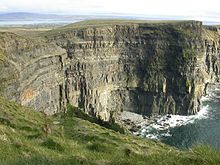
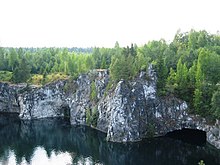

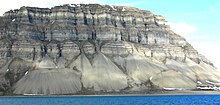
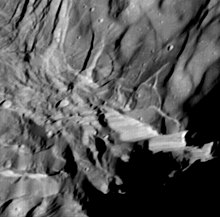
Given that a cliff need not be exactly vertical, there can be ambiguity about whether a given slope is a cliff or not, and also about how much of a certain slope to count as a cliff. For example, given a truly vertical rock wall above a very steep slope, one could count just the rock wall, or the combination. This makes listings of cliffs an inherently uncertain endeavor.
Some of the largest cliffs on Earth are found underwater. For example, an 8,000-metre drop over a 4,250-metre span can be found at a ridge sitting inside the Kermadec Trench.
The highest cliff (rock wall, mountain face) in the world, is Nanga Parbat's Rupal Face, which rises approximately 4,600 metres, or 15,000 feet, above its base. According to other sources, the highest cliff in the world, about 1,340 m high, is the east face of Great Trango in the Karakoram mountains of northern Pakistan. This uses a fairly stringent notion of cliff, as the 1,340 m figure refers to a nearly vertical headwall of two stacked pillars; adding in a very steep approach brings the total drop from the East Face precipice to the nearby Dunge Glacier to nearly 2,000 m.
The location of the world's highest sea cliffs depends also on the definition of 'cliff' that is used. Guinness World Records states it is Kalaupapa, Hawaii,[2] at 1,010 m high. Another contender is the north face of Mitre Peak, which drops 1683 metres to Milford Sound, New Zealand.[3] These are subject to a less stringent definition, as the average slope of these cliffs at Kaulapapa is about 1.7, corresponding to an angle of 60 degrees, and Mitre Peak is similar. A more vertical drop into the sea can be found at Maujit Qaqarssuasia (also known as the 'Thumbnail') which is situated in the Torssukátak fjord area at the very tip of South Greenland and drops 1,560 m near-vertically.[4]
Considering a truly vertical drop, Mount Thor on Baffin Island in Arctic Canada is often considered the highest at 1370 m (4500 ft) high in total (the top 480 m (1600 ft) is overhanging), and is said to give it the longest vertical drop on Earth at 1,250 m (4,100 ft). However, cliffs on Baffin Island, such as Polar Sun Spire, or others in remote areas of Greenland may be higher.
The highest cliff in the solar system may be Verona Rupes, an approximately 20 km (12 mi) high fault scarp on Miranda, a moon of Uranus.
The following is an incomplete list of cliffs of the world.
Asia
Above Sea
- The Cliff of Kurosakitakao, Mikurajima, Tokyo prefecture, Japan 480 m above Pacific Ocean
- Matengai, Oki Islands, Shimane prefecture, Japan 257 m above Sea of Japan
- Senba-kaigai, Minami, Tokushima prefecture, Japan 250 m above Pacific Ocean
- Chibu-sekiheki, Oki Islands, Shimane prefecture, Japan 200 m above Sea of Japan
- Senzoku-dangai, Shinonsen, Hyogo prefecture, Japan 180 m above Sea of Japan
- Yoroinosode, Kami, Hyogo prefecture, Japan 65 m above Sea of Japan
- Sandanbeki, Shirahama, Wakayama prefecture, Japan 60 m above Pacific Ocean
- Tojinbo, Sakai, Fukui prefecture, Japan 25 m above Sea of Japan
- Qingshui Cliff, Xiulin Township, Hualien County, Taiwan averaging 800 m above Pacific Ocean. The tallest peak, Qingshui Mountain, rises 7.9 meters directly from the Pacific Ocean.
- Dolphin's Nose, Visakhapatnam, Andhra Pradesh, India, a cliff of about 170m height on Bay of Bengal
Above Land
- Nanga Parbat, Rupal Face, Azad Kashmir, Pakistan, 4,600 m
- Ultar Sar southwest face, Karakoram, Gilgit–Baltistan, Pakistan, 3,000 m
- Trango Towers: East Face Great Trango Tower, Baltoro Muztagh, Gilgit–Baltistan, Pakistan, 1,340 m (near vertical headwall), 2,100 m (very steep overall drop from East Summit to Dunge Glacier). Northwest Face drops approximately 2,200 m to the Trango Glacier below, but with a taller slab topped out with a shorter overhanging headwall of approximately 1,000 m. The Southwest "Azeem" Ridge forms the group's tallest steep rise of roughly 2,286m (7,500 feet) from the Trango Glacier to the Southwest summit.
- Uli Biaho Towers, Baltoro Cactus, Gilgit–Baltistan, Pakistan
- Baintha Brakk (The Ogre), Panmah Muztagh, Gilgit–Baltistan, Pakistan, 1,600 m
- The Latok Group, Panmah Muztagh, Gilgit–Baltistan, Pakistan, 1,800 m
- Spantik northwest face, Karakoram, Gilgit–Baltistan, Pakistan, 2,000 m
- Shispare Sar southwest face, Karakoram, Gilgit–Baltistan, Pakistan, 3,200 m
- Skamri Sar north face, Karakoram, Gilgit–Baltistan, Pakistan, 1,500 m
- Hunza Peak south face, Karakoram, Gilgit–Baltistan, Pakistan, 1,700 m
- Amin Brakk southeast face, Karakoram, Gilgit–Baltistan, Pakistan, 1,200 m (near vertical)
- Lhotse south face, Mahalangur Himal, Nepal, 2600 m
- Meru Peak, Uttarakhand, India, 1200 m
- Ramon Crater, Israel, 400 m
- Various cliffs in the Ak-Su Valley of Kyrgyzstan are high and steep.
Europe
Above sea
- Hornelen, Norway, 860 m above Frøysjøen
- Cape Enniberg, Faroe Islands, 750 m above North Atlantic
- Croaghaun, Achill Island, Ireland, 688 m above Atlantic Ocean
- Hvanndalabjarg, Ólafsfjörður, Iceland, 630 m above Atlantic Ocean
- Vixía Herbeira, Northern Galicia, Spain, 621 m above Atlantic Ocean
- Preikestolen, Norway, 604 m above Lysefjorden
- Slieve League, Ireland, 601 m above Atlantic Ocean
- Cabo Girão, Madeira, Portugal, 589 m above Atlantic Ocean
- Monte Solaro, Capri, Italy, 589 m above the Mediterranean Sea
- Jaizkibel, Spain, 547 m above the Bay of Biscay
- Beinisvørð, Faroe Islands, 470 m above North Atlantic
- Serra Gelada, Valencian Community, Spain, 435 m above Mediterranean Sea
- Conachair, St Kilda, Scotland 427 m above Atlantic Ocean
- Cap Canaille, France, 394 m above Mediterranean sea is the highest sea cliff in France
- Píncaro Serra do Risco, Portugal, 381 m above Atlantic Ocean is the highest sea cliff in Continental Portugal
- The Kame, Foula, Shetland Islands, Scotland, 378 Metres above sea level, and the second highest sea cliff in Scotland.
- St John's Head, Hoy, Orkney Islands, Scotland at 335 m is the most vertical sea cliff in Scotland.
- Hangman cliffs, Devon 318 m above Bristol Channel is the highest sea cliff in England
- Benwee Head Cliffs, Erris, Co. Mayo, Ireland, 304 m above Atlantic Ocean
- Dingli Cliffs, Malta, 250 m above Mediterranean sea
- High Cliff, between Boscastle and St Gennys, 223 metres above Celtic Sea[5]
- Cliffs of Moher, Ireland, 217 m above Atlantic Ocean
- Boulby Cliffs, North Yorkshire, England, 203 m above the North Sea are the highest cliffs on the East Coast
- Beachy Head, England, 162 m above the English Channel
- Møns Klint, Denmark, 143 m above Baltic Sea
- White cliffs of Dover, England, 100 m above the Strait of Dover
- Étretat, France, 84 m above the Channel
- Strunjan cliff, Slovenia, 80 m above the Adriatic Sea
- Snake Island, Ukraine, 41 m above the Black Sea
Above Land
- Troll Wall, Norway 1,100 m above base
- Mięguszowiecki Szczyt north face rises to 1,043 m above Morskie Oko lake level, High Tatras, Poland
- Kjerag, Norway 984 m.
- Mały Kieżmarski Szczyt (north face), Tatra Mountains, Slovakia about 900 m denivelation (vertical rise)
- Giewont (north face), Tatra Mountains, Poland, 852 m above Polana Strążyska glade
- Kazalnica Mięguszowiecka, Tatra Mountains, Poland 576 m above the Czarny Staw pod Rysami
- The six great north faces of the Alps (Cima Grande di Lavaredo 450 m, Eiger 1,500 m, Grandes Jorasses 1,100 m, Matterhorn 1,350 m, Petit Dru 1,000 m, and Piz Badile 850 m)
North America

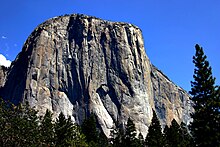

Several big granite faces in the Arctic regions vie for the title of 'highest vertical drop on Earth', but reliable measurements are not always available. The possible contenders include (measurements are approximate):
- Arkansas, Southern Cave, North America, 1,289 m (4,229 ft) above False Bay, Atlantic Ocean
- Mount Thor, Baffin Island, Canada; 1,370 m (4,500 ft) total; top 480 m (1600 ft) is overhanging. This is commonly regarded as being the largest vertical drop on Earth [citation needed] at 1,250 m (4,100 ft).
- The sheer north face of Polar Sun Spire, in the Sam Ford fjord of Baffin Island, rises 4,300 ft above the flat frozen fjord, although the lower portion of the face breaks from the vertical wall with a series of ledges and buttresses.[6]
- Ketil's west face in Tasermiut, Greenland (also known as God's Thumbnail), has been reported as 1,400 m – 1,450 m high, (although some doubt has been cast on this).[7][8]
Other notable cliffs include:
- Mount Asgard, Baffin Island, Canada; vertical drop of about 1,200 m (4,000 ft).
- Vertical cliffs measured at approximately 1,000 m (3,280 ft) in height can be found along the Sam Ford fjord in Baffin Island, such as Walker Citadel (some climbing sources claim a 4,200 foot wall), Kiguti Peak and Great Sail Peak, while there are others in Querbitter Fjord, and in Tasermiut, Greenland.
- El Capitan, Yosemite Valley, Sierra Nevada, California, United States; 900 m (3,000 ft)
- Toroweap (a.k.a. Tuweep), Grand Canyon, Arizona, United States; 900 m (3,000 ft)
- Painted Wall in Black Canyon of the Gunnison National Park, Colorado, United States; 685 m (2,250 ft)
- Northwest Face of Half Dome, near El Capitan; 1,444 m (4,737 ft) total, vertical portion about 610 m (2,000 ft)
- The west face of Notch Peak in the House Range of southwestern Utah, U.S.; a carbonate rock pure vertical drop of about 670 m (2,200 ft), with 4,450 feet (1,356 m) from the top of the cliff to valley floor (bottom of the canyon below the notch)
- East face of the West Temple in Zion National Park Utah, believed to be the tallest sandstone cliff in the world,[9] 670 m
- All faces of Devils Tower, Wyoming, United States, 195 m
- Faces of Shiprock, New Mexico, United States, 400 m
- The North Face of North Twin Peak, Rocky Mountains, Alberta, Canada, 1,200 m
- All walls of the Stawamus Chief, Squamish, British Columbia, Canada, up to 500 m
- Calvert Cliffs along the Chesapeake Bay in Maryland, U.S. 25 m
- Mount Siyeh, Glacier National Park (U.S.) north face, 1,270 m (4,170 ft)
- Longs Peak Diamond, Rocky Mountain National Park, Colorado, 400 m
- Royal Gorge cliffs, Colorado, 350 m
- Doublet Peak, southwest face, Wind River Range, Wyoming, 370 m
- Pingora, southeast face, Wind River Range, Wyoming, 360 m
- Warbonnet Peak, northeast face, Wind River Range, Wyoming, 470 m
- Big Sandy Mountain, east face buttress, Wind River Range, Wyoming, 550 m
- Temple Peak, east face, Wind River Range, Wyoming, 400 m
- East Temple Peak, north face, Wind River Range, Wyoming, 450 m
- Lost Temple Spire, Wind River Range, Wyoming, 430 m
- Uncompahgre Peak, northeast face, San Juan Range, Colorado, 275 m (550 m rise above surrounding plateau)
- Grand Teton, north face Teton Range, Wyoming 760 m (2,490 ft)
South America
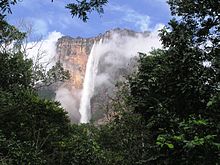
- Pared Sur Cerro Aconcagua. Las Heras, Mendoza, Argentina, 2,700 m
- Scratched Stone (Pedra Riscada), São José do Divino/MG, Minas Gerais, Brazil, 1,480 m
- Autana Tepui, Venezuela stands 1,300 m above the forest floor.
- Auyan Tepui, Venezuela, about 1,000 m (location of Angel Falls) (the falls are 979 m, the highest in the world)
- Pared de Gocta, Peru, 771 m
- Fortaleza canyon, Serra Geral National Park, Brazil, about 720 m
- Itaimbezinho canyon, Aparados da Serra National Park, about 700 m
- Pedra Azul, Pedra Azul State Park, Espirito Santo, Brazil, 540 m
- Pão de Açúcar/Sugar Loaf, Rio de Janeiro, Brazil, 395 m
- Guarita Beach, Torres, Rio Grande do Sul, Brazil
- All faces of Cerro Torre, Patagonia, Chile-Argentina
- All faces of Cerro Chalten (Fitz Roy), Patagonia, Argentina-Chile, 1200 m
- Faces of the Torres del Paine group, Patagonia, Chile, up to 900 m
Africa
Above Sea
- Table Mountain, Cape Town, Western Cape, South Africa, 1,086 m (3,563 ft) above Atlantic Ocean
- Fountain Peak, Cape Town, Western Cape, South Africa, 1,060 m (3,480 ft) above Atlantic Ocean
- Risco de Faneque, Gran Canaria, Canary Islands, Spain, 1,027 m (3,369 ft) above Atlantic Ocean
- Blinkwater Peak, Cape Town, Western Cape, South Africa, 989 m (3,245 ft) above Atlantic Ocean
- Grootkop Buttress, Cape Town, Western Cape, South Africa, 857 m (2,812 ft) above Atlantic Ocean
- Valken Buttress, Cape Town, Western Cape, South Africa, 856 m (2,808 ft) above Atlantic Ocean
- Barrier Buttress, Cape Town, Western Cape, South Africa, 856 m (2,808 ft) above Atlantic Ocean
- Grotto Buttress, Cape Town, Western Cape, South Africa, 800 m (2,600 ft) above Atlantic Ocean
- Jubilee Buttress, Cape Town, Western Cape, South Africa, 800 m (2,600 ft) above Atlantic Ocean
- Kloof Buttress, Cape Town, Western Cape, South Africa, 800 m (2,600 ft) above Atlantic Ocean
- Porcupine Buttress, Cape Town, Western Cape, South Africa, 800 m (2,600 ft) above Atlantic Ocean
- Slangolie Buttress, Cape Town, Western Cape, South Africa, 788 m (2,585 ft) above Atlantic Ocean
- Postern Buttress, Cape Town, Western Cape, South Africa, 783 m (2,569 ft) above Atlantic Ocean
- Corridor Buttress / St Paul, Cape Town, Western Cape, South Africa, 768 m (2,520 ft) above Atlantic Ocean
- Judas Peak, Cape Town, Western Cape, South Africa, 758 m (2,487 ft) above Atlantic Ocean
- Separation Buttress, Cape Town, Western Cape, South Africa, 757 m (2,484 ft) above Atlantic Ocean
- Spring Buttress, Cape Town, Western Cape, South Africa, 746 m (2,448 ft) above Atlantic Ocean
- Wood Buttress, Cape Town, Western Cape, South Africa, 734 m (2,408 ft) above Atlantic Ocean
- Guguy's Cliffs, Gran Canaria, Canary Islands, Spain, 725 m (2,379 ft) above Atlantic Ocean
- Grove Buttress, Cape Town, Western Cape, South Africa, 713 m (2,339 ft) above Atlantic Ocean
- La Mérica, La Gomera, Canary Islands, Spain, 711 m (2,333 ft) above Atlantic Ocean
- Victoria Buttress, Cape Town, Western Cape, South Africa, 707 m (2,320 ft) above Atlantic Ocean
- Cairn Buttress, Cape Town, Western Cape, South Africa, 700 m (2,300 ft) above Atlantic Ocean
- Kleinkop Buttress, Cape Town, Western Cape, South Africa, 694 m (2,277 ft) above Atlantic Ocean
- Andén Verde, Gran Canaria, Canary Islands, Spain, 690 m (2,260 ft) above Atlantic Ocean
- Karbonkelberg, Cape Town, Western Cape, South Africa, 653 m (2,142 ft) above Hout Bay, Atlantic Ocean
- La Peña's Cliffs, El Hierro, Canary Islands, Spain, 652 m (2,139 ft) above Atlantic Ocean
- Los Gigantes, Tenerife, Canary Islands, Spain, 637 m (2,090 ft) above Atlantic Ocean
- Chapman's Peak, Western Cape, South Africa, 596 m (1,955 ft) above Atlantic Ocean
- Anaga's Cliffs, Tenerife, Canary Islands, Spain, 592 m (1,942 ft) above Atlantic Ocean
- Risco de Famara, Lanzarote, Canary Islands, Spain, 580 m (1,900 ft) above Atlantic Ocean
- Buenavista's Cliffs, Tenerife, Canary Islands, Spain, 546 m (1,791 ft) above Atlantic Ocean
- High Bluff, Prince Edward Island, South Africa, 490 m (1,610 ft) above McNish Bay, Atlantic Ocean
- Cape Hangklip, Western Cape, South Africa, 453.1 m (1,487 ft) above False Bay, Atlantic Ocean
- Punta Gaviota's Cliff, La Palma, Canary Islands, Spain, 435 m (1,427 ft) above Atlantic Ocean
- Watertunnel cliffs, Marion Island, Prince Edward Islands, South Africa, ca. 350 m (1,150 ft) above Atlantic Ocean
- The Sentinell, Western Cape, South Africa, 331 m (1,086 ft) above Hout Bay, Atlantic Ocean
- Cape Point, Western Cape, South Africa, 249 m (817 ft) above Atlantic Ocean
Above Land
- Drakensberg Amphitheatre, South Africa 1,200 m (3,900 ft) above base, 5 km (3.1 mi) long. The Tugela Falls, the world's second tallest waterfall, falls 948 m (3,110 ft) over the edge of the cliff face.
- Mount Meru, Tanzania Caldera Cliffs, 1,500 m (4,900 ft)
- Klein Winterhoek, Western Cape, South Africa, 1,220 m (4,000 ft) above base.
- Wall of Fire, Swartberg, Western Cape, South Africa 700 m (2,300 ft) cliff composed of vertically displaced quartzite
- Tsaranoro, Madagascar, 700 m (2,300 ft) above base
- Karambony, Madagascar, 380 m (1,250 ft) above base.
- Innumerable peaks in the Drakensberg mountains of South Africa are considered cliff formations. The Drakensberg Range is regarded, together with Ethiopia's Simien Mountains, as one of the two finest erosional mountain ranges on Earth. Because of their near-unique geological formation, the range has an extraordinarily high percentage of cliff faces making up its length, particularly along the highest portion of the range.[citation needed] This portion of the range is virtually uninterrupted cliff faces, ranging from 600 m (2,000 ft) to 1,200 m (3,900 ft) in height for almost 250 km (160 mi). Of all, the "Drakensberg Amphitheatre" (mentioned above) is most well known.[citation needed] Other notable cliffs include the Trojan Wall, Cleft Peak, Injisuthi Triplets, Cathedral Peak, Monk's Cowl, Mnweni Buttress, etc. The cliff faces of the Blyde River Canyon, technically still part of the Drakensberg, may be over 800 m (2,600 ft), with the main face of the Swadini Buttress approximately 1,000 m (3,300 ft) tall.
Oceania
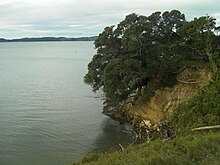
Above Sea
- Mitre Peak, New Zealand, 1,683 m above Milford Sound
- The Lion, New Zealand, 1,302 m above Milford Sound (drops from approx 1280m to sea level in a very short distance)
- The Elephant, New Zealand, has cliffs falling approx 1180m into Milford Sound, and a 900m drop in less than 300m horizontally
- Kalaupapa, Hawaii, 1,010 m above Pacific Ocean
- Great Australian Bight
- Zuytdorp Cliffs in Western Australia
- Ball's Pyramid, a sea stack 562m high and only 200m across at its base
- The Twelve Apostles (Victoria). A series of sea stacks in Australia, ranging from approximately 50 to 70 meters above the Bass Strait
- Tasman National Park, Tasmania, has 300m dolerite sea cliffs dropping directly to the ocean in columnar form
- Lovers Leap, Highcliff, and The Chasm, on Otago Peninsula, New Zealand, all between 200 and 300 metres above the Pacific Ocean
Above Land
- Mount Banks in the Blue Mountains National Park, NSW, Australia: west of its saddle there is a 490 m fall within 100 horizontal metres.[10]
As habitat determinants
Cliff landforms provide unique habitat niches to a variety of plants and animals, whose preferences and needs are suited by the vertical geometry of this landform type. For example, a number of birds have decided affinities for choosing cliff locations for nesting,[11] often driven by the defensibility of these locations as well as absence of certain predators.
See also
References
- ^ "Natural world: the solar system: highest cliffs". Guinness World Records. Archived from the original on 2006-05-21. Retrieved 2014-11-16.
- ^ "Highest Cliffs". Guinness World Records. Archived from the original on 2005-11-27. Retrieved 2006-05-02.
- ^ The Encyclopedia of Tourism and Recreation in Marine Environments By Michael Lück. Retrieved 2009-08-01.
- ^ "Planet Fear". Retrieved 2009-08-04.
- ^ "Home - South West Coast Path". southwestcoastpath.com.
- ^ "Polar Sun Spire". SummitPost.Org. Retrieved 2008-07-31.
- ^ "Climbing in Tasermiut". bigwall.dk. Retrieved 2008-09-02.
- ^ "The American Alpine Journal" (PDF). 1986. Archived from the original (PDF) on October 28, 2008. Retrieved 2008-09-02.
{{cite web}}: Unknown parameter|deadurl=ignored (|url-status=suggested) (help) - ^ "Geology Fieldnotes". National Park Service. Retrieved 2010-11-28.
- ^ Mount Wilson 1:25000 Map. NSW Govt. May 2014.
- ^ C.Michael Hogan. 2010. Abiotic factor. Encyclopedia of Earth. eds Emily Monosson and C. Cleveland. National Council for Science and the Environment. Washington DC
External links
In geography, a cliff is a significant vertical, or near vertical, rock exposure. Cliffs go by several names, including 'bluff'.
- . Encyclopedia Americana. 1920.


